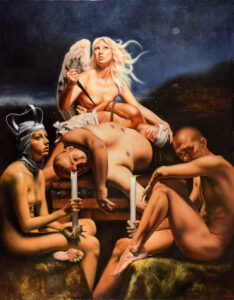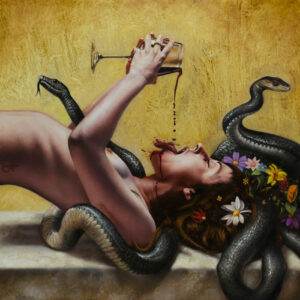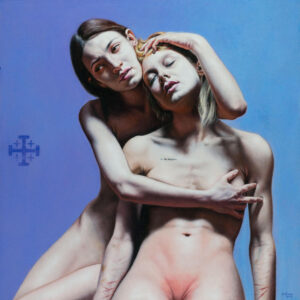Sacred art today can cause a sensation and give rise to sterile and foolish controversies; this is the case of the Venetian artist Saturno Buttò who tries to dissect the human soul through painting, emphasizing the most unpleasant and disturbing aspects that weird out those looking with eyes gazing at the Beato Angelico or Annibale Carracci’s “figurines”.
Analina Grasso: Which artists have most influenced your artistic path?
Saturno Buttò: Hellenistic art, our Renaissance and somehow Hollywood glamour were a great stimulus for my research. I must also add some contemporary photographers, such as Joel Peter Witkin, Robert Mapplethorpe, Andres Serrano. On the other hand, I don’t find references in twentieth century painting, with the exception of Francis Bacon, I have never felt particularly interested in other visual artists. In summary, the model on which I base my work is a combination of classical art (technical support) and non-documentary photographic research (conceptual part).
Is successful contemporary art only the reproducible and conceptual one?
I would say yes. And this is how it should be. I affirm it in spite of myself, since my research goes in the opposite direction. In other words, I consider uniqueness and non-reproducibility to be a high point of artwork. Unfortunately, the problem with these media (I am referring to painting and sculpture) is almost always the total lack of originality and contemporaneity of the representation. A sort of anachronism that permeates the work of traditional painters and sculptors, mostly focused on demonstrating their technical skill rather than risking unpopularity by pursuing more original paths. There are exceptions (at least I hope so, of course), but it is a bit like it happened in the last century with Lucian Freud, Balthus, and Bacon himself. Few artists of great personality simply “not aligned” and therefore unmanageable by the art market.
In “The intoxicated bride” a secular rite seems to take place where wine makes the Christian ecstasy possible however with bizarre implications…
In some way it could also be read like this. After all, it is my opinion that there are many common points between Paganism and Christianity. In this case, from the sacrament of marriage, the bride and the two bridesmaids are transformed into priestess and bacchantes of who knows what ritual, thanks to wine. My aim was to manifest an idiosyncrasy towards rules in general. To put it sinthetically: the Dionysian chaos that takes over the Apollonian order. This is a chaos towards which also Hermann Nitsch has well directed us.
Contemporary art expresses complex poetics precisely in the interdisciplinary overcoming of the dichotomies between man and technology. How do you deal with this phenomenon?
It is the prerogative of art to anticipate changes and mutations of the social order. More and more we are witnessing a new path undertaken by humanity that will lead us to live with situations where the dichotomy between man and technology will no longer be such. It is a reflection that has accompanied me for a long time, however I do not think I have the appropriate technical tools to fully express this phenomenon. The extrapictorial media are definitely more suitable. With figurative art, in order not to end up into “trivial illustrative solutions”, we must pay attention to small details capable of hinting at such poetics. A more difficult path, but not an unlikely one… Basically this is the problem of traditional arts compared to new media. If it is not clear enough, I am definitely critical toward figurative art. Including mine, of course.
However doesn’t that sound like a contradiction? What does it mean to be against something you are witnessing?
It is my awareness and it does not bother me that it sounds like a contradiction. Mine is a general speech. And anyway I am not at all against figurative art, I am only against decorative art as an end in itself. I am not sure about the quality of my works, and I have a critical position a priori. This should serve to grow artistically.
The main characters of your works seem to be spied on rather than accompanied or looked at with loving kindness by God, is this partly so?
Of course it is! This is a legacy of the Catholic religion that has instilled in us the idea of sin, which, it should be clear, I find stimulating. Also because then there is forgiveness, albeit after a sincere repentance and here we could discuss… However, my representations have, very often, to do with rituals considered sinful or in any case with decidedly intimate practices linked to both religiosity and sexuality.
Which exhibition do you remember with more pleasure?
I am particularly attached to more than one solo exhibitions, for example those in Rome, Los Angeles and San Francisco. But I will mention the Spinea solo show in 2018, because the place was truly magical. Not a gallery but a 17th century church where my works interacted with the local frescoes. In addition, for the occasion, I created what for me could turn out to be the only possible altarpiece Paradise Decadence (just because it was a deconsecrated church).
What do you think is most annoying or irritating about your works?
I believe that people, even today, expect to observe in a figurative painting themes in line with the pictorial tradition. Therefore, subjects such as the landscape, still life and the portrait. And in the case of the latter, that it should be substantially “composed”, delegating to photography or other extra-pictorial media, so to speak, “different themes”. On the contrary, it amuses me the idea of touching deeper chords by painting! Excluding landscapes and still lifes that do not belong to me, because in representing the human figure I want to go deep into the soul and highlight completely personal, intimate aspects, emphasizing the transience and caducity of the physical aspect. Above all, I would like to reiterate how close issues such as sexuality and spirituality are. Just think of Bernini’s Saint Teresa: the artwork is a perfect example of my way of seeing. It is completely normal for someone to find my way of representing the world disturbing, but that is fine with me! In any case, I am aware of how much any statement is extremely relative.
(translated by Luisa Pettener)
Info:
Agnani (FR): 21 – 31 agosto 2021, Palazzo Bonifacio VIII “Tra inferno e Paradiso” a cura di Michele Citro
(michele.citro87@gmail.com)
Padova: 30 ottobre 2021 – 31 gennaio 2022, Museo Eremitani “A riveder le stelle” a cura di Barbara Codogno
(anubi31@gmail.com)
 Saturno Buttò, The Sacrifice, 2013, olio su tavola, cm 160 x 125, proprietà dell’artista, courtesy Simard-Bilodeau Contemporary di Los Angeles
Saturno Buttò, The Sacrifice, 2013, olio su tavola, cm 160 x 125, proprietà dell’artista, courtesy Simard-Bilodeau Contemporary di Los Angeles
 Saturno Buttò, Leda-ctonia, 2018, olio su tavola, cm 70 x 70, proprietà dell’artista, courtesy Mishin fine art di San Francisco
Saturno Buttò, Leda-ctonia, 2018, olio su tavola, cm 70 x 70, proprietà dell’artista, courtesy Mishin fine art di San Francisco
 Saturno Buttò, O-RH negative, 2019, olio su tavola, cm 70 x 70, proprietà dell’artista, courtesy Mishin fine art di San Francisco
Saturno Buttò, O-RH negative, 2019, olio su tavola, cm 70 x 70, proprietà dell’artista, courtesy Mishin fine art di San Francisco
 Saturno Buttò, Pietas, 2020, olio su tavola, cm 70 x 70, courtesy The Bank Contemporary Art Collection
Saturno Buttò, Pietas, 2020, olio su tavola, cm 70 x 70, courtesy The Bank Contemporary Art Collection
Journalist, blogger and social media editor from Campania. i graduated in literature and philology and I gained a master in art and organization of cultural events. I love cinema, art, music, literature, especially Russian, French and Italian. I read a lot, both narrative and non-fiction. I share Picasso’s thoughts on art: “Art helps us to recognize the truth”.






NO COMMENT